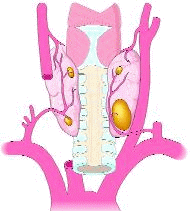An Overactive Parathyroid Gland Can Cause Hyperparathyroidism, Leading to Serious Health Problems If Left Untreated
If you have been diagnosed with a parathyroid adenoma, you will no doubt have many questions for your doctor. You doctor may have explained to you that one or more of your parathyroid glands is overactive, but how will this affect you? How serious is it? Parathyroid adenomas are not uncommon. The condition affects both genders but is seen more in women, usually over the age of 60. This article will help you to understand more about parathyroid adenoma and what type of treatment can be expected.
What are the parathyroid glands?
You actually have four parathyroid glands. They are located in your neck, situated behind your thyroid gland. These little glands are quite small, about the size of a grain of rice or a small pea. Like the thyroid gland, they are part of the endocrine system but their function is quite different than that of the thyroid gland. The function of the parathyroid glands is to regulate the calcium, phosphorus and vitamin D levels in your body. They do this by producing a hormone known as the parathyroid hormone, also known as PTH or parathormone.
According to the National Cancer Institute, when one or more of your parathyroid glands becomes overactive it produces too much PTH. Too much PTH in your bloodstream causes your calcium levels to be too high, as the calcium stored in your bones is pulled from the bones into your bloodstream. This causes your bones to become weak and fragile. An elevated PTH levels also causes your intestines to absorb too much calcium. This too increases the calcium level in the blood.
A parathyroid adenoma can lead to a condition known as hyperparathyroidism. There are basically two types of hyperparathyroidism, primary and secondary. Primary hyperparathyroidism is caused when one or more of the parathyroid glands enlarge. Secondary hyperparathyroidism is caused by other diseases within the body that are affecting the calcium level. Interestingly, when a patient has a parathyroid adenoma, the unaffected parathyroid glands become inactive or dormant in an effort to help control the high calcium levels.
How is this diagnosed?
Many people have no symptoms of this condition, especially if it is a mild case. The doctor will usually be the first to notice a problem when he reviews your routine lab work. Normally, your calcium level should be in the range of 8.5 to 10.5 mg/dl (milligrams per deciliter), or 2.25 to 2.75 mmol/L. If your calcium levels are high, your doctor will order a PTH level (parathyroid hormone) level. The normal range for the PTH is 10 to 55 pg/mL (picograms per milliliter). Elevation of both the calcium level and PTH level gives your doctor strong evidence that something unusual is going on with your parathyroids glands.
Your doctor will then check your phosphorus and chloride levels and may also check your kidney function by ordering a 24-hour urine collection. An ultrasound, MRI and bone density tests may also be needed as he determines whether you have primary or secondary hyperparathyroidism. A test known as a Sestamibi scan can confirm the location of the parathyroid glands and whether or not they are enlarged.
Symptoms
Many patients with parathyroid adenoma don’t initially notice any specific symptoms. Symptoms, however, can and do occur, especially if your PTH levels are elevated over a long period of time. Some of the more common symptoms of hyperparathyroidism can include tiredness, loss of appetite, nausea, constipation and vomiting. As the condition progresses, symptoms can include bone pain, joint pain, fractures, development of kidney stones, mental confusion and memory loss. When you consider how the body uses calcium under normal conditions, you can see how these symptoms can occur when the calcium levels are too high.
How can a parathyroid adenoma be treated?
Although there are a few medications that may help treat hyperparathyroidism, the treatment of choice to correct parathyroid adenoma.







